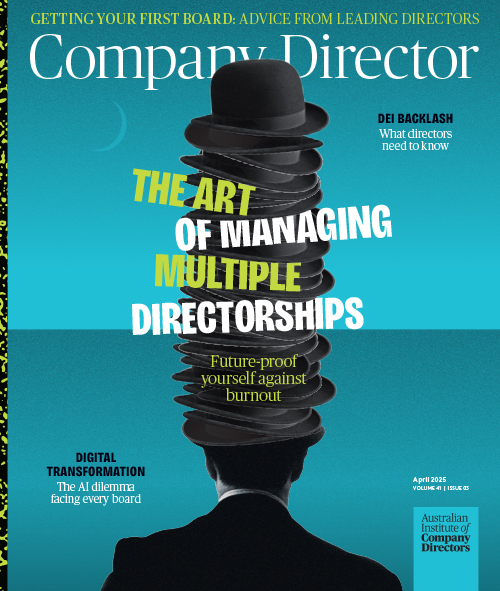The AICD is providing practical guidance to help Australian directors meet their positive duty obligations to prevent workplace sexual harassment and similar harmful conduct, and to prepare for new enforcement powers.
The Respect@Work report released by the Australian Human Rights Commission (AHRC) made a key recommendation for the introduction of a positive duty for employers to take reasonable and proportionate measures to prevent workplace sexual harassment and a range of similar harmful conduct, such as sex discrimination, hostile working environments and victimisation conduct. The positive duty now applies to all employers, however, “reasonable and proportionate” measures will vary depending on the organisation and be assessed on factors such as its nature, size, circumstances and resources available.
The AICD publication Positive Duty to Prevent Workplace Sexual Harassment — a Director’s Guide was released to support directors in meeting their obligations. A recent webinar hosted by AICD, which discussed the guide, is summarised here.
Workplace sexual harassment is prevalent and pervasive, said Australian Sex Discrimination Commissioner Dr Anna Cody (pictured above). “It occurs in every industry, in every location and at every level in Australian workplaces.”
The commissioner added that relying on responses to complaints has not been effective. Reducing the number and incidents of sexual harassment requires “positive action by employers that’s proportionate to their size and nature”.
“What works to eliminate sexual harassment and sex discrimination in one workplace will be different from what works in another,” said Cody.
Focus targets
Leadership, knowledge, risk management and culture will be key. Three areas to focus response efforts on are support, reporting and response, and monitoring, evaluation and transparency.
Positive duty covers more than just sexual harassment. It also covers sex discrimination and sex-based harassment in a work context, behaviour that leads to a hostile work environment on the grounds of sex, and related acts of victimisation.
“Leaders send strong messages to their entire organisations through their words and actions about what’s acceptable, important and valued in an organisation,” said Cody. “Leaders play a critical role in creating change and effectively implementing measures to prevent and respond to harmful and discriminatory behaviours — from approving corporate policies to appointing executive leadership and management roles.”
It’s vital to investigate the structural barriers that prevent equality for certain cohorts, she said. “It may be about addressing gender pay gaps, introducing more flexible working arrangements or ensuring that culturally and racially marginalised First Nations women, and women with disability, are represented in leadership positions. Having a diverse leadership group from different backgrounds with different lived experience will not only mean you are contributing to the positive duty and its achievement, but it also makes for better decision- making and a more inclusive work culture.”
Getting the culture right
The new regulatory powers come into force on 12 December 2023. From that date, the AHRC will have the power to conduct inquiries into compliance and provide recommendations to achieve compliance; issue compliance notices, setting out what a duty holder must do or refrain from doing to comply with the positive duty; and it will be able to apply to the Federal Court for an order to direct compliance and enter into enforceable undertakings with duty holders.
The commission will be able to commence an inquiry when it reasonably suspects an organisation is not compliant with the positive duty. If the commission identifies non-compliance, it can offer to work with an organisation on a voluntary basis to help it meet its legal obligations.
“We’re of the view that participation and cooperation will build trust and confidence in the positive duty as a measure to reduce workplace sex-based discrimination and sexual harassment, and to support equality in Australian workplaces,” said Cody.
Webinar panellist Susie Corlett GAICD, a geologist, has 30 years’ experience in the mining industry and is a non-executive director at Iluka Resources. “Around my board tables, the moral reputation and legal risks are really front of mind,” she said. “We’ve focused on the competence and the confidence of our leaders, employees and contractors in understanding the nature, drivers and impacts of sexual harassment and [ensured there is] an understanding of the actions they can take to prevent, support and respond to victims that raise an incident in the workplace. We’re also providing resources in order to meet this need for education, knowledge and competence.”
Also on the panel was Manufacturing Australia chair James Fazzino. “We think if we can create a culture of inclusion and respect that’s free from harassment, that’s a real positive,” he said. “That’s how we win in the war for talent. So we see this as a real tool we can use to drive competitive advantage in the business, rather than an onerous duty. The question we’re asking is, why is it unsafe for our people to report cases of harassment? And what can we do about that?”
The author of the guide, Dr Karen O’Connell, an associate professor at UTS Law, noted that, “culture is going to be the driver of so many of the practical measures that we would consider to be part of the positive duty”.
“The starting point is setting the values that you want to build on,” said O’Connell. “It’s building that rock-solid foundation of a culture, a shared culture. Boards driving that, leading that, encouraging that, reflecting on that, following up on it, is what I would love to see.”
This article first appeared under the headline 'Protect Your People’ in the December 2023 / January 2024 issue of Company Director magazine.
Latest news
Already a member?
Login to view this content



